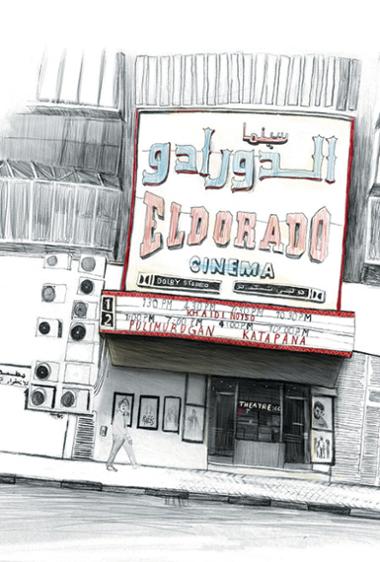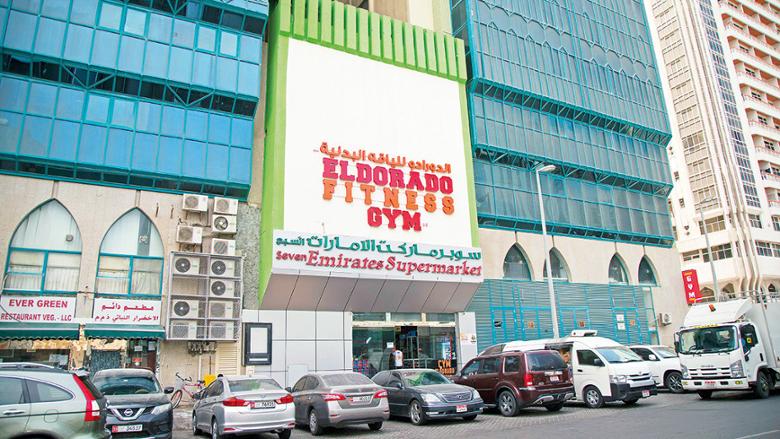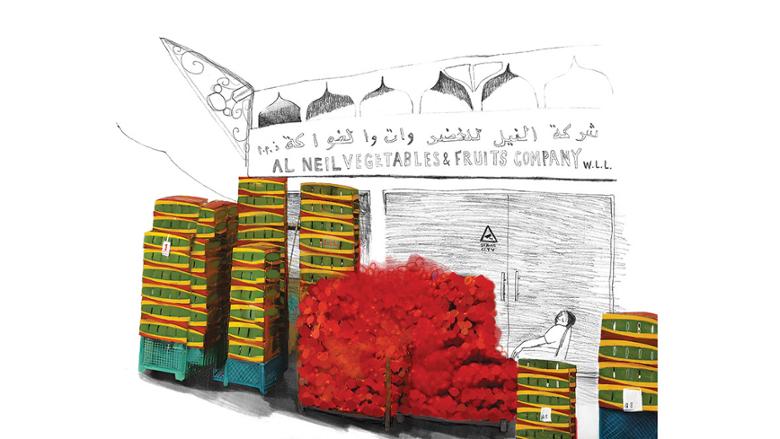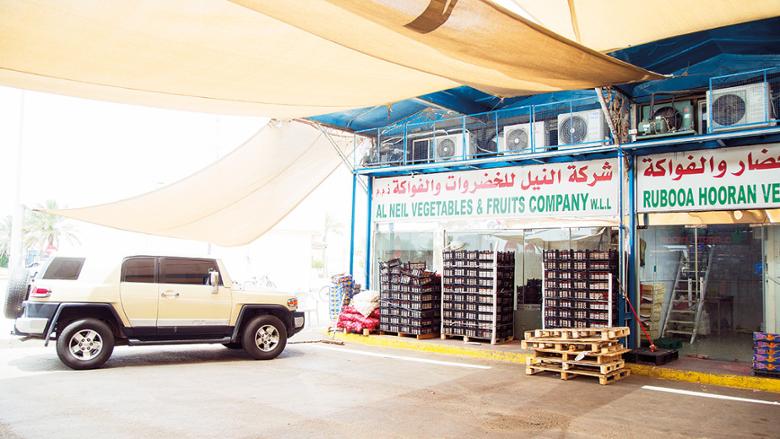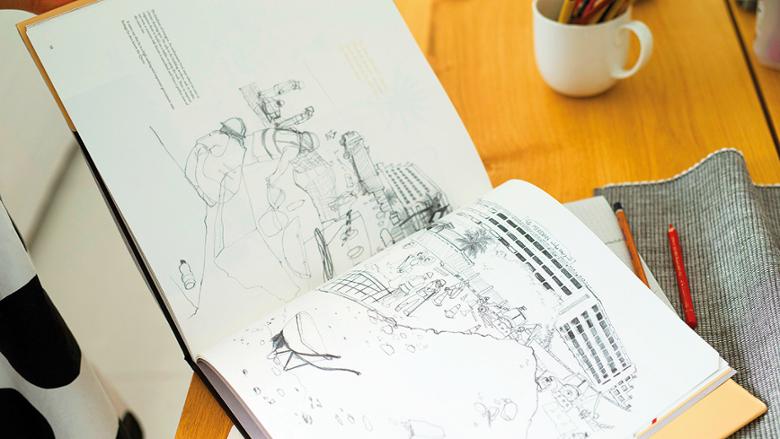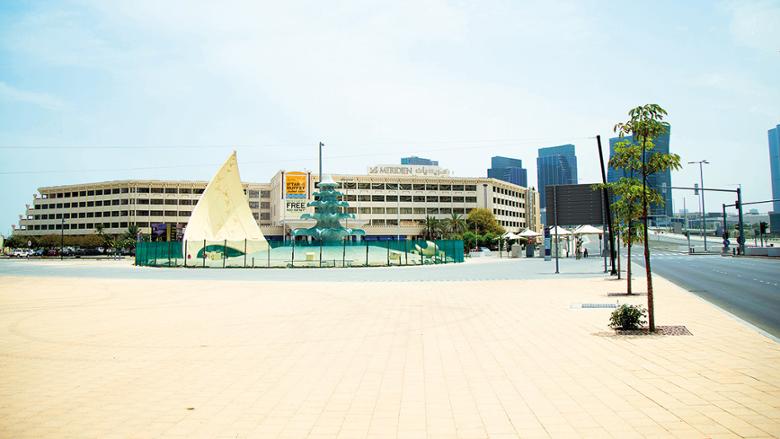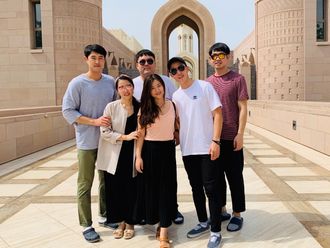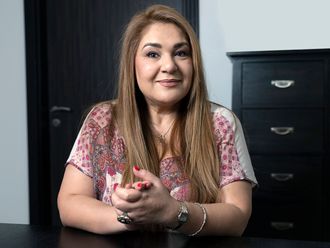
What makes a neighbourhood? How do people claim social spaces and make it their own? And how do communities grow around it? It was to delve into these questions further and to document real-life neighbourhood areas as part of the practical research for her Master’s degree in Illustration that Abu Dhabi resident Cath Donaldson first stepped out of her comfort zone and into hitherto unfamiliar, unseen areas of the city. Soon she found herself mapping the streets of Abu Dhabi, learning its history and being attentive to the day-to-day life unfolding within its thoroughfares, markets and urban centres, with the aim of bringing to life the places and people around her.
‘Rather than ordered and structured spaces, my aim was to identify neighbourhoods that had a strong community feel and which were also in the process of change,’ says Cath, who had taught graphic design and illustration at college and university level in the UK.
With two grown-up sons and a 17-year-old daughter, it was the move to Abu Dhabi that reignited in Cath the idea of pursuing the long-cherished dream of an MA degree, a dream that had been relegated to the background amid her family and career responsibilities.
‘When I commenced on the project in September 2017, I had been in Abu Dhabi for 18 months,’ she narrates, seated in her 13th floor apartment at the World Trade Center Residences in central Abu Dhabi. ‘Although the places I ventured into were unfamiliar terrain, the subject – of defining spaces more by how it is used rather than physical boundaries – was very close to my heart.”
Even as a child, she had been intrigued by places and buildings and how people made use of these spaces. Her favourite childhood pastime, says the artist who won the Benson and Hedges Illustrators Gold award following her graduation with first class honours, “was to spread out huge sheets of paper in the garden, and make imaginary maps and places with boxes I had collected.”
Decades later, she found herself hopping on to pavements and kerbs and into alleys and side-streets in the capital in a bid to identify localities she wanted to illustrate. Her initial idea was to walk through and map areas in the city but the challenges were many.
[Souqs, drones, hammour with wings: this colouring book will make you want to rediscover Dubai]
‘Streets had no names or proper numbers; not even Google Maps helped much,’ she recollects. ‘Many roads had four to five different names, and addresses often ended in names of prominent buildings in the area – like a supermarket, a bakery or cinema, for example – some of which no longer exist.’
The city, she adds, ‘was demarcated by places and landmarks familiar to only those living there; it’s a reference that exists only in the memory of its residents.’
Deciding that it was impossible to map in the conventional sense, Cath chose to make her own map as she walked; marking the building sites, businesses and people she met. It soon filled up 13 sketch books and began to spill over into more reams of paper.
The neighbourhoods she eventually chose were all selected for their strong identity – the markets of Al Mina; Hamdan (roughly the blocks between 5th and 7th street); and the Tourist Club Area, now known as Al Zahiyah. ‘These were places that had a distinctive atmosphere, were home to a mix of nationalities, and it was interesting to see how the predominantly Indian, Pakistani and Bangladeshi communities that lived here have carved spaces for themselves within the larger social space.’
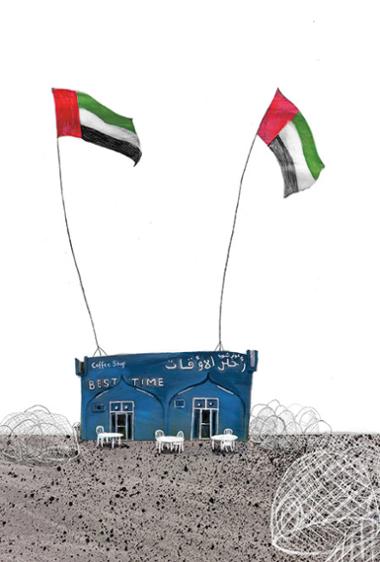
There was also concern that these areas were not being recorded, she adds. ‘Abu Dhabi is a multi-cultural, multi-national city but it is still a young city. The first paved roads here came up only in 1966 but the transformation since then has been phenomenal. Here, change is rapid and constant and this is why I found value in recording the everyday life, before it is consigned to memory.’
When you record a place, you are making your version and interpretation of it; and drawing a place must ‘fix’ it as a tangible account of your experience, she explains while leafing through the pages of Neighbourhood Abu Dhabi, the final outcome of her eight-month project. Through these sketchbook drawings and studio paintings, we are introduced to everyday life in the fruit and veg market where men are up at work from dawn, where fresh produce is piled high and canopies are hung between rows of stalls to keep the hot sun off.
We see images of a quiet date market that springs to life when the cruise liners arrive, bringing along tourists, one even wearing a leopard-skin cloak. She has also captured the iconic El Dorado cinema, a popular landmark and Abu Dhabi’s first indoor cinema, before it downed its shutters in November 2017 and which ‘is still a neighbourhood name and a marker on the memory of the map of the city.’
Her distinctive style of reportage illustration which, she explains, ‘is drawing from real life, on location’ reveals layers of the city’s multicultural and social composition. The subjects are representative of the place, and the drawings reflect the lives of the close communities that live there.
Deeply conscious of the fact that she was an outsider to the area, in addition to being white, female and Western, it was drawing that allowed her to build a relationship with the people and the places, she asserts. ‘They approached me, talked to me and some even drew on my drawings. They brought water and fruit and shared stories, and this broke down barriers.
‘Drawing allowed me to become part of the action, of the event,’ she says, highlighting its advantage over photography. ‘It cut through the social awkwardness as it seems less invasive than a camera.’
To show us the places she frequented while working on her project, Cath takes us on a drive through the well laid out, grid-patterned roads of Abu Dhabi, driving past swanky high-rises, broad boulevards and busy thoroughfares. One of the reasons for beginning this project, she says, ‘was the realisation that, for many people, there is a genuine misconception about life in the UAE, and the larger Middle East. So, it was my intention to record things as they are as opposed to the elitist, glamorous city images portrayed in tourist brochures.’
As we approach the site of the former El Dorado cinema, she exclaims in surprise as the supermarket that had replaced it now also flanks a brand-new El Dorado Fitness Centre in the building’s upper storey. Opening her book, Cath shows us the image of the theatre whose pink and blue neon lights had once lit up Electra Street ‘but with the change in use of the building, life around it has changed too.’
Natalie Malas, who came to Abu Dhabi at the age of six in 1982 and has lived here since, remembers she had watched Titanic at El Dorado in 1997. ‘There was a popular burger joint next to it where all ‘cool’ kids would go,’ she says. ‘My best friend lived here, and it was a busy area with lots of department stores and shops lining the streets.’
Today, there are double parked vehicles on the lanes and the background noise is of air conditioners and traffic horns. In the evenings though, it transforms into a communal space as chairs are brought out, and people congregate in groups or sit on the high kerbs, says Cath.
As we move on to the port area where the markets are, Cath tells us that Al Mina is one of the oldest neighbourhoods in Abu Dhabi. ‘There are several markets here including the fruit and vegetable sellers, the date market, a fish market serviced by a fleet of dhows, a plant market and the Iranian souk for household goods. Across the road is the Afghan carpet souk and the livestock and bird markets.’
The Port area is where she enjoyed drawing the most, she says. ‘Everybody knew each other here; it was fascinating to watch the general camaraderie amongst them.’
What is also interesting, she adds, ‘is how they began to take pride in their shop when they realised that was what I was drawing. They began to look at it with new eyes and some of them would pose for me in all earnestness.’
Just as it broke barriers, her interactions with the menfolk in this neighbourhood also shattered several misconceptions. ‘I met a man at the fruit stall whose son was at Oxford University! He beamed with pride as he showed me pictures of his family, and the large house he had built for them.’
At the fish market in the Mina area, Cath is disappointed to discover that the row of cafés facing the dhow harbour and which previously had tables and chairs laid out in front, with fishing nets spread out alongside, were now cordoned off with tall fencing that said ‘Demolition in progress.’
Although demolition is a natural part of a city’s growth cycle, and is required for urban areas to evolve, it is sad to see such strong neighbourhood community spaces vanish overnight, she says. ‘Places like these are important because they showcase the ethos of the neighbourhood.’
For Natalie, the Mina market has been imprinted in her memory ‘since forever.’
‘I cannot remember going to any other market for fruits and vegetables,’ she says. ‘You can find anything you want here, at bargain prices too. The home supplies market is still my go-to place when looking for a hidden gem or a bargain.’
However, 73-year-old MV Sivaraman, who arrived in Abu Dhabi just before the formation of the UAE,says buildings alone do not account for the history of a place. In 1978, when he opened his tailoring shop in Central Market – an open air market on Hamdan Street that housed around 200 shops – ‘it was the only market in Abu Dhabi at the time and people thronged it throughout the year.’
A fire gutted it down in 2003 and although the vendors had to relocate to new areas, Sivaraman is happy with his new space at Madinat Zayed Shopping Centre where his Dabster Gents Tailoring and Textiles is one of the most popular outlets. ‘I have a much larger space here and can now sell clothing material as well,’ says the master tailor who is renowned for his perfect-fitting tuxedos and dinner jackets. ‘The quality of the products at the mall is far superior to what was available at the old souq. The Central Market is gone but we have a whole new set of clientele and business is much better than before.’
What he misses, he says, is the vibrant festive atmosphere that enveloped the market, especially during Ramadan every year. ‘That is something no mall, however big or modern, can ever hope to replicate.’
The Souk and the World Trade Center complex now stand in the place of the former market and incidentally, this is where Cath Donaldson currently resides.
We have now reached the Tourist Club Area that forms the northernmost corner of Abu Dhabi Island. Developed for recreation in the early 1970s with a club, a beach and marina, bowling and a swimming pool, this was where everyone came to relax, and it was an area buzzing with activity, Cath says.
Today, the buzz remains as road projects, underpasses, bridges and expressways are changing its landscape every single day. Although it was renamed ‘Al Zahiyah’ (‘colourful’ in Arabic) in 2014, the old Tourist Club name is still used by those who live and work here, she adds.
When Cath embarked on her ‘Neighbourhood’ project, this area was a vast construction site with trucks, boom loaders, cables, traffic barriers and cones, as is illustrated in her book. Today, the surveyors and labourers are all gone and a new bridge connects the old and new parts of Abu Dhabi.
The only building that escaped unscathed in the new master development plan is the Le Meridien Hotel, probably because of its iconic status as a hotel where the late Shaikh Zayed had hosted a lunch for Queen Elizabeth four decades ago for its grand opening, explains Cath.
In Natalie’s memory, the Tourist Club Area ‘is a place of beautiful memories of my childhood. I have since witnessed everything getting torn down – the volcano fountain, clock tower, the old corniche with its beautiful umbrellas, lamps, fountains, and lush greenery – and new buildings replacing them.’
While it is marvellous to see new structures come up, the connection to your past gets lost in the process, she believes. ‘Landmarks that remind me of the old days still make me nostalgic; especially the bus station, Muroor Bridge and Musalla Al Eid areas. These neighbourhoods are symbolic of the spirit of the old city as even today these remain untouched, unchanged.’
Cath’s biggest takeaway from working on the project, she says, has been the kindness of strangers. ‘I was overwhelmed by their generosity as I have never experienced this in any other city that I have drawn in,’ says the artist who is now hoping to find a publisher for her book.
It is the little things that struck an emotional chord. She describes an Asian worker who brought out a chair for her. ‘His room opened out on to the street in an alleyway, and all he owned was within that space no bigger than a car. Yet, he went to the baqala (store) and bought water and an apple for me. I saw him check out three apples before he chose the perfect one!’
That gesture really moved her. ‘I felt ashamed too for he had hardly anything but he graciously gave me all that he had.’
She also remembers how at the Tourist Club Area, an elderly UAE national called out to the building workers to build a concrete slab ‘throne’ so she could get the perfect view of the entire site.
‘I had hoped to be a mere observant in this journey,’ says Cath, but in the end, the act of drawing turned out to be a transformative experience, building real connections between the subject and herself. ‘It was much more than I had ever hoped for and now, like everyone else, I too have claimed my place here and am happy and proud to call Abu Dhabi home.’



